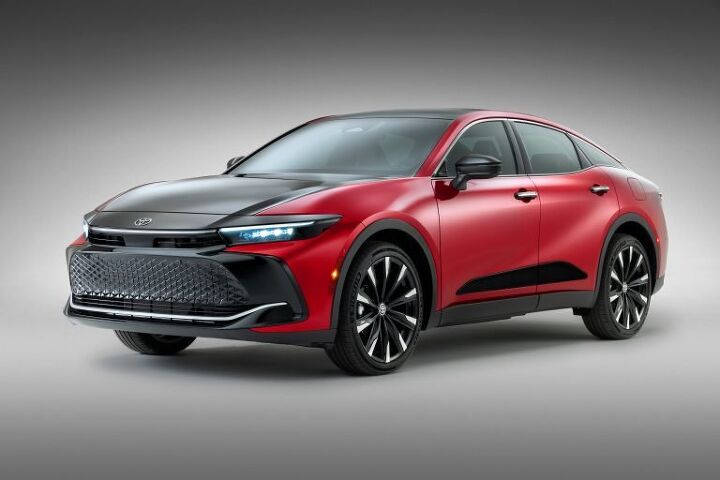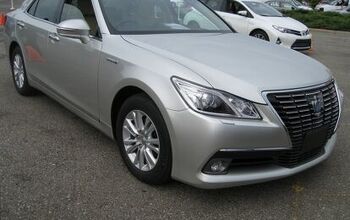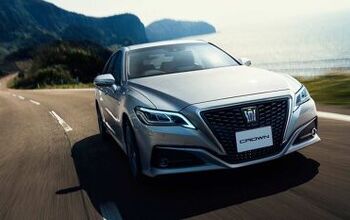Crown Royal: Toyota Crown Returns to America

Students of automotive history will know the Toyota Crown has sat atop the aspirational ladder in Japan since the 1950s and hasn’t been part of the Big T’s portfolio in America since 1973 when it was replaced by the Corona. Our own Murilee can expound on this family tree in excruciating detail, which is one of the many reasons we appreciate his ramblings.
Now, the Crown in back in this country. Technically replacing the Avalon, it’s a hybrid-powered four-door vehicle (car? SUV?) with a conventional sedan trunk opening sitting on a structure that places it four inches higher than a Camry. If Toyota was looking to defy categorization as it brought the Crown name back to America for the first time in five decades, it has definitely succeeded.
There will be three trim levels, all of which will be familiar to the Toyota faithful – XLE, Limited, and Platinum. Powering the first two is a 2.5-liter four-banger which has a nickel-metal hydride battery pack and three electric motors as its dance partners. This configuration is good for a claimed 236 horsepower and knocks on the door of 40 mpg in combined driving conditions with its CVT. Thanks to the placement of those motors, these Crowns are all-wheel drive.
Platinum-grade models are the recipient of an annoyingly capitalized HYBRID MAX powertrain, which we henceforth will never capitalize again. Here, we find a 2.4-liter turbocharged four-cylinder engine mated to a six-speed, wet-clutch transmission which does the two-step with a hybrid system made of a battery and two electric motors, the latter of which is liquid-cooled on the rear axle. Toyota says these gubbins make 340 horsepower, but fuel economy drops to an estimated 28 mpg on the combined cycle.
The snazzier hybrid system flings power to all four wheels consistently, while the XLE and Limited trims can be front-wheel drive in certain conditions. Thanks to the Hybrid Max’s rear motor which generates power through water cooling, Platinum trims can send up to 80 percent of its power to the rear wheels for – hopefully – tail-out action on loose surfaces.
But what about its appearance? What, indeed. Using the TNGA-K platform, it seems like the Crown is attempting to meld sedan driving comfort with crossover-like ride height. If you want to reference the Subaru Legacy SUS or AMC Eagle Sedan in the comments, we won’t stop you. Taking a measuring tape to the Crown offers an overall height of 60.6 inches (compared to 56.9 for a Camry), length of 194.0 inches on a 112.2-inch wheelbase, and 72.4-inch width.
For reference, a 2022 Highlander is listed as being 68.1 inches tall, 194.9 inches long (112.2-inch w/b), and 76.0 inches wide. If you’ve noted its wheelbase is identical to the Crown, give yourself a gold star. Both vehicles are built using the TNGA-K bones which currently underpin a yaffle of Toyota vehicles from Venza to Sienna and RAV4 to Camry. The old Avalon used it as well. The Crown’s interior is familiar to anyone who’s been in a new Toyota recently, which isn’t a bad thing.
Availability is set for this autumn, though Toyota was mum on price. For what it’s worth, the 215-horsepower Avalon Hybrid currently starts at $37,850 so we expect the Crown to push past $40k to start.
[Images: Toyota]

Matthew buys, sells, fixes, & races cars. As a human index of auto & auction knowledge, he is fond of making money and offering loud opinions.
More by Matthew Guy
Latest Car Reviews
Read moreLatest Product Reviews
Read moreRecent Comments
- Honda1 Unions were needed back in the early days, not needed know. There are plenty of rules and regulations and government agencies that keep companies in line. It's just a money grad and nothing more. Fain is a punk!
- 1995 SC If the necessary number of employees vote to unionize then yes, they should be unionized. That's how it works.
- Sobhuza Trooper That Dave Thomas fella sounds like the kind of twit who is oh-so-quick to tell us how easy and fun the bus is for any and all of your personal transportation needs. The time to get to and from the bus stop is never a concern. The time waiting for the bus is never a concern. The time waiting for a connection (if there is one) is never a concern. The weather is never a concern. Whatever you might be carrying or intend to purchase is never a concern. Nope, Boo Cars! Yeah Buses! Buses rule!Needless to say, these twits don't actual take the damn bus.
- MaintenanceCosts Nobody here seems to acknowledge that there are multiple use cases for cars.Some people spend all their time driving all over the country and need every mile and minute of time savings. ICE cars are better for them right now.Some people only drive locally and fly when they travel. For them, there's probably a range number that works, and they don't really need more. For the uses for which we use our EV, that would be around 150 miles. The other thing about a low range requirement is it can make 120V charging viable. If you don't drive more than an average of about 40 miles/day, you can probably get enough electrons through a wall outlet. We spent over two years charging our Bolt only through 120V, while our house was getting rebuilt, and never had an issue.Those are extremes. There are all sorts of use cases in between, which probably represent the majority of drivers. For some users, what's needed is more range. But I think for most users, what's needed is better charging. Retrofit apartment garages like Tim's with 240V outlets at every spot. Install more L3 chargers in supermarket parking lots and alongside gas stations. Make chargers that work like Tesla Superchargers as ubiquitous as gas stations, and EV charging will not be an issue for most users.
- MaintenanceCosts I don't have an opinion on whether any one plant unionizing is the right answer, but the employees sure need to have the right to organize. Unions or the credible threat of unionization are the only thing, history has proven, that can keep employers honest. Without it, we've seen over and over, the employers have complete power over the workers and feel free to exploit the workers however they see fit. (And don't tell me "oh, the workers can just leave" - in an oligopolistic industry, working conditions quickly converge, and there's not another employer right around the corner.)




































Comments
Join the conversation
Ok, fellas. This proves Toyota was listening when you told us about sedans and your hip joints. Who's buying one first?
This thing is as bloated as a the average housewife at McDonald's.